Sizing Up Servers: Intel's Skylake-SP Xeon versus AMD's EPYC 7000 - The Server CPU Battle of the Decade?
by Johan De Gelas & Ian Cutress on July 11, 2017 12:15 PM EST- Posted in
- CPUs
- AMD
- Intel
- Xeon
- Enterprise
- Skylake
- Zen
- Naples
- Skylake-SP
- EPYC
Intel’s Turbo Modes
A last minute detail from Intel yesterday was information on the Turbo modes. As expected, not all of the processors actually run at their rated/base frequency: most will apply a series of turbo modes depending on how many cores are registered as ‘active’. Each core can have its frequency adjusted independently, allowing VMs to take advantage of different workload types and not be hamstrung by occupants on other VMs in the same socket. This becomes important when AVX, AVX2 and AVX-512 are being used at the same time.
Most of the turbo modes are a sliding scale, with the peak turbo used when only one or two cores are active, sliding down to a minimum frequency that may be the ‘base’ frequency or just above it. There’s a lot of information for the parts here, so we’ll break it down into stages.
First up, a look at the Platinum 8180 in the different modes:
It should be worth noting what the base frequency actually is, and some of the nuance in Intel’s wording here. The base frequency is the guaranteed frequency of the chip – Intel sells the chip with the base frequencies as the guarantee, such that when the chip is not idle and not in normal conditions (i.e. when not in thermal power states to reduce temperature) should operate at this frequency or above it. Intel also lists the per-core turbo frequencies as ‘Maximum Core Frequencies’ indicating that the processors could be running lower than listed, depending on power distribution and requirements in other areas of the chip (such as the uncore, or memory controller). It’s a vague set of terms but ultimately the frequency is determined on the fly and can be affected by many factors, but Intel guarantees a certain amount and provides guides as to what it expects the turbo frequencies to be.
As for the Platinum 8180, it keeps its top turbo modes while up to two cores are active, and then drops down. It does this again for another two cores, and a further two cores. From this point, under non-AVX load the CPU is pretty much the same frequency until >20 cores are loaded, but does not decrease that much in all. For AVX 2.0 and AVX-512, the downward slope of more cores means less frequency continues, with AVX-512 taking a bigger jump down at 13 cores loaded. The final turbo frequency for AVX-512 running on all cores is 2.3 GHz.
Comparing the two 28-core CPUs for which we have turbo information gives this graph. The numbers relate to the number of cores need to be loaded for that frequency.
Both processors are equal to each other for dual core loading, but the separation occurs when more cores are loaded. As we move through to AVX 2.0 and AVX-512, it is clear where the separations are in performance – to get the best for variable core loading, the more expensive processors are required.
Here’s the big table for all the processors on Non-AVX loading:
Despite the 2.0/2.1 GHz base on most of the Platinum series, all the CPUs will turbo up to 3.7-3.8 GHz on low core loading except for the lower power Platinum 8153. For users wanting to strike a good balance between the core count and frequency, the Gold 6154 is probably the place to be: 18 cores that will only ever run at 3.7 GHz with non-AVX loading (3.5-2.7 GHz on AVX-512 depending on core count), and will be $3543 as a list price at 205W. It is perhaps worth noting that this will likely top any of the Core i9 processors planned: at 18-cores and 205W for 3.7 GHz, the Core i9-7980XE which will have 18 cores but run 165W will likely be clocked lower (but also only ~$2000).
Moving onto AVX2.0 and AVX-512:


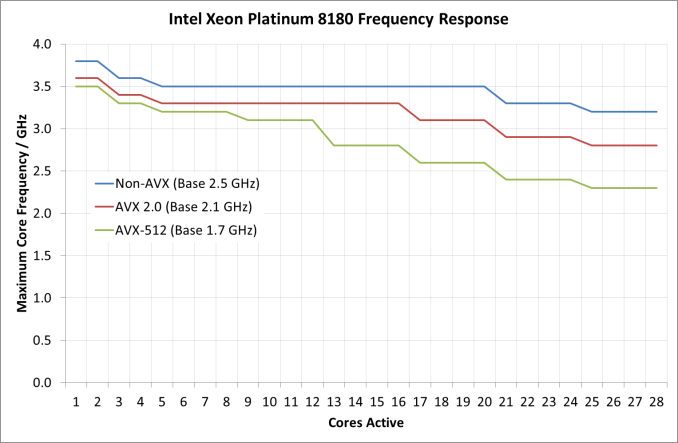
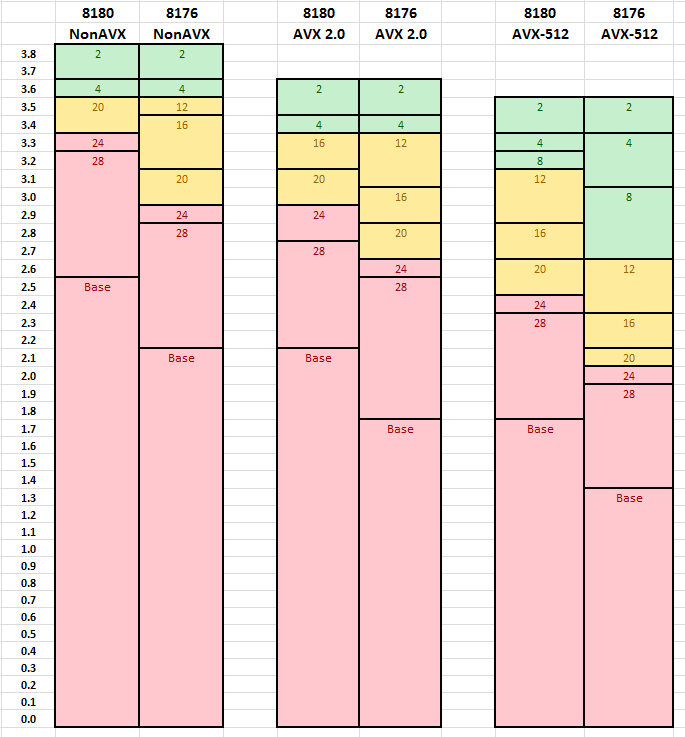
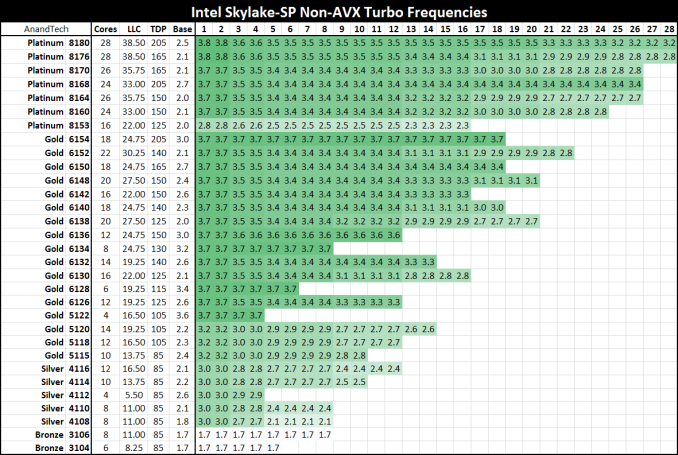
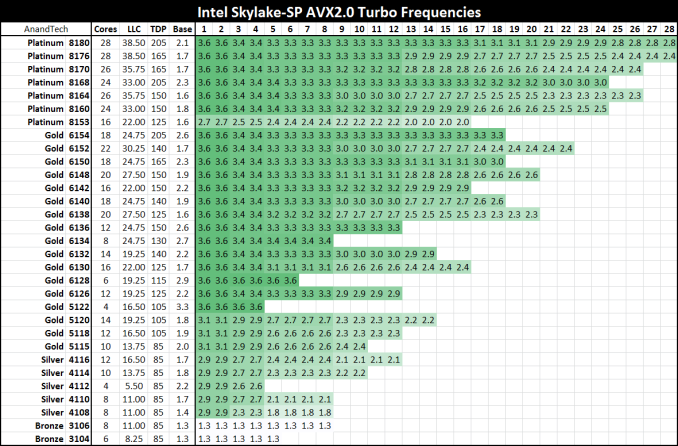
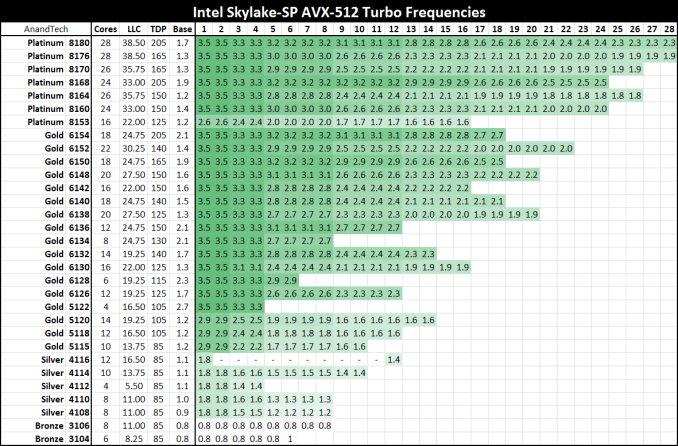








219 Comments
View All Comments
Shankar1962 - Wednesday, July 12, 2017 - link
AMD is fooling everyone one by showing more cores, pci lanes, security etcCan someone explain me why GOOGLE ATT AWS ALIBABA etc upgraded to sky lake when AMD IS SUPERIOR FOR HALF THE PRICE?
Shankar1962 - Wednesday, July 12, 2017 - link
Sorry its BaiduPretty sure Alibaba will upgrade
https://www.google.com/amp/s/seekingalpha.com/amp/...
PixyMisa - Thursday, July 13, 2017 - link
Lots of reasons.1. Epyc is brand new. You can bet that every major server customer has it in testing, but it could easily be a year before they're ready to deploy.
2. Functions like ESXi hot migration may not be supported on Epyc yet, and certainly not between Epyc and Intel.
3. Those companies don't pay the same prices we do. Amazon have customised CPUs for AWS - not a different die, but a particular spec that isn't on Intel's product list.
There's no trick here. This is what AMD did before, back in 2006.
blublub - Tuesday, July 11, 2017 - link
I kinda miss Infinity Fabric on my Haswell CPU and it seems to only have on die - so why is that missing on Haswell wehen Ryzen is an exact copy?blublub - Tuesday, July 11, 2017 - link
argh that post did get lost.zappor - Tuesday, July 11, 2017 - link
4.4.0 kernel?! That's not good for single-die Zen and must be even worse for Epyc!AMD's Ryzen Will Really Like A Newer Linux Kernel:
https://www.phoronix.com/scan.php?page=news_item&a...
Kernel 4.10 gives Linux support for AMD Ryzen multithreading:
http://www.pcworld.com/article/3176323/linux/kerne...
JohanAnandtech - Friday, July 21, 2017 - link
We will update to a more updated kernel once the hardware update for 16.04 LTS is available. Should be August according to Ubuntukwalker - Tuesday, July 11, 2017 - link
You mention an OpenFOAM benchmark when talking about the new mesh topology but it wasn't included in the article. Any way you could post that? We are trying to evaluate EPYC vs Skylake for CFD applications.JohanAnandtech - Friday, July 21, 2017 - link
Any suggestion on a good OpenFoam benchmark that is available? Our realworld example is not compatible with the latest OpenFoam versions. Just send me an e-mail, if you can assist.Lolimaster - Tuesday, July 11, 2017 - link
AMD's lego design where basically every CCX can be used in whatever config they want be either consumer/HEDT or server is superior in the multicore era.Cheaper to produce, cheaper to sell, huge profits.